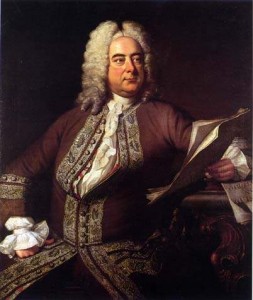Handel, Ombra mai fu (from Xerxes)
 Most everyone knows Handel’s Messiah, but Handel was primarily an opera composer. Oratorios followed the operatic style while omitting the staging in deference to Lent. The opera Xerxes (Serse) was written in 1738. It had little success, but the aria Ombra mai fu is frequently performed.
Most everyone knows Handel’s Messiah, but Handel was primarily an opera composer. Oratorios followed the operatic style while omitting the staging in deference to Lent. The opera Xerxes (Serse) was written in 1738. It had little success, but the aria Ombra mai fu is frequently performed.
The subject of countertenors can be a bit complicated. In the polyphonic music of the Renaissance, all of the parts were typically sung by male voices. Upper parts were often sung by boys, who sing naturally in the soprano and alto range. Mature males might also sing the higher parts in falsetto, a term denoting an unnaturally high voice that has a flute-like sound and generally lacks much vocal character. Choral ensembles with men and boys are in widespread use still today.
The rise of male castrati in the late Renaissance and early Baroque further complicates the picture. While castrati retained a high vocal register upon maturity, they developed an adult’s full vocal capacity and power. They were superstars of early opera, through the time of Handel, until their popularity waned in the 18th century.
But men trained naturally to sing in the register above tenor, the alto or countertenor range, have had a place throughout this history. And there is something of a resurgence of countertenors today, particularly in Baroque operatic repertoire but also in contemporary works. Come to think of it, male voices in the countertenor range gained a strong footing in popular music at the same time. Think of the sounds produced by the Beach Boys, the Bee Gees, Michael Jackson, and numerous others. Jesus Christ Superstar has a countertenor role, as does Leonard Bernstein’s Chichester Psalms.
So it’s not just a phenomenon of old music or more serious music, but something found across many times and styles.



